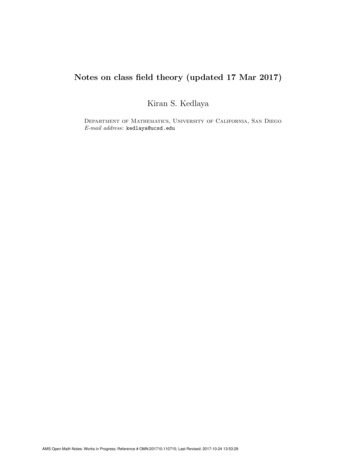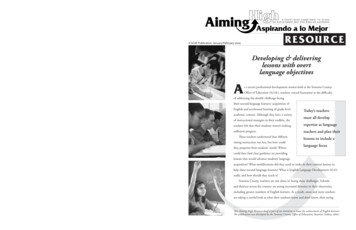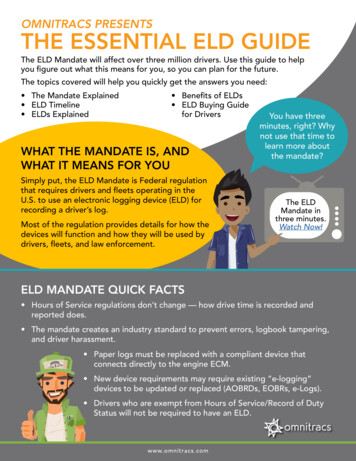
Transcription
Notes on class field theory (updated 17 Mar 2017)Kiran S. KedlayaDepartment of Mathematics, University of California, San DiegoE-mail address: kedlaya@ucsd.eduAMS Open Math Notes: Works in Progress; Reference # OMN:201710.110715; Last Revised: 2017-10-24 13:53:29
AMS Open Math Notes: Works in Progress; Reference # OMN:201710.110715; Last Revised: 2017-10-24 13:53:29
ContentsPrefacePart 1.iiiTrailer: Abelian extensions of the rationals1Chapter 1.The Kronecker-Weber theorem3Chapter 2.Kummer theory7Chapter 3.The local Kronecker-Weber theorem11The statements of class field theory15Part 2.Chapter 4.The Hilbert class field17Chapter 5.Generalized ideal class groups and the Artin reciprocity law19Chapter 6.The principal ideal theorem23Chapter 7.Zeta functions and the Chebotarev density theorem27Part 3.Cohomology of groups29Chapter 8.Cohomology of finite groups I: abstract nonsense31Chapter 9.Cohomology of finite groups II: concrete nonsense35Chapter 10.Homology of finite groups41Chapter 11.Profinite groups and infinite Galois theory45Part 4.Local class field theory49Chapter 12.Overview of local class field theory51Chapter 13.Cohomology of local fields: some computations55Chapter 14.Local class field theory via Tate’s theorem61Chapter 15.Abstract class field theory67Part 5.The adelic formulation75Chapter 16.Adèles and idèles77Chapter 17.Adèles and idèles in field extensions83iAMS Open Math Notes: Works in Progress; Reference # OMN:201710.110715; Last Revised: 2017-10-24 13:53:29
iiCONTENTSChapter 18.Part 6.The adelic reciprocity law and Artin reciprocityThe main results8589Chapter 19.Cohomology of the idèles I: the “First Inequality”91Chapter 20.Cohomology of the idèles II: the “Second Inequality”95Chapter 21.An “abstract” reciprocity map101Chapter 22.The existence theorem105Chapter 23.The connection with local reciprocity107Part 7.CodaChapter 24.Parting thoughtsAMS Open Math Notes: Works in Progress; Reference # OMN:201710.110715; Last Revised: 2017-10-24 13:53:29113115
PrefaceThis text is a lightly edited version of the lecture notes of a course on class fieldtheory (Math 254B) that I gave at UC Berkeley in the spring of 2002. To describethe scope of the course, I can do no better than to quote from the original syllabus:Class field theory, the study of abelian extensions of numberfields, was a crowning achievement of number theory in the firsthalf of the 20th century. It brings together, in a unified fashion,the quadratic and higher reciprocity laws of Gauss, Legendreet al, and vastly generalizes them. Some of its consequences(e.g., the Chebotarev density theorem) apply even to nonabelianextensions.Our approach in this course will be to begin with the formulations of the statements of class field theory, omitting the proofs(except for the Kronecker-Weber theorem, which we prove first).We then proceed to study the cohomology of groups, an important technical tool both for class field theory and for many otherapplications in number theory. From there, we set up a localform of class field theory, then proceed to the main results.The assumed background for the course was a one-semester graduate course inalgebraic number theory, including the following topics: number fields and rings ofintegers; structure of the class and unit groups; splitting, ramification, and inertiaof prime ideals under finite extensions; different and discriminant; basic propertiesof local fields. In fact, most of the students in Math 254B had attended such acourse that I gave the previous semester (Math 254A) based on chapters I, II, andIII of Neukirch’s Algebraic Number Theory; for that reason, it was natural to usethat book as a primary reference. However, no special features of that presentationare assumed, so just about any graduate-level text on algebraic number theory (e.g.,Fröhlich-Taylor, Janusz, Lang) should provide suitable background.After the course ended, I kept the lecture notes posted on my web site in theiroriginally written, totally uncorrected state. Despite their roughness, I heard backfrom many people over the years who had found them useful; as a result, I decidedto prepare a corrected version of the notes. In so doing, I made a conscious decisionto suppress any temptation to modify the presentation with the benefit of hindsight,or to fill in additional material to make the text more self-contained. This decision,while largely dictated by lack of time and energy, was justified by the belief that theinformality of the original notes contributed to their readibility. In other words,this is not intended as a standalone replacement for a good book on class fieldtheory!iiiAMS Open Math Notes: Works in Progress; Reference # OMN:201710.110715; Last Revised: 2017-10-24 13:53:29
ivPREFACEI maintain very few claims of originality concerning the presentation of thematerial. Besides Neukirch, the main source of inspiration was Milne’s lecturenotes on algebraic number theory (see http://jmilne.org/math/CourseNotes/cft.html, version 3.10; note that a more recent version is available, but we have notverified that all references remain valid). These two sources are referenced simplyas “Neukirch” and “Milne,” with additional references described more explicitly asthey occur. The basic approach may be summarized as follows: I follow Milne’streatment of local class field theory using group cohomology, then follow Neukirchto recast local class field theory in the style of Artin-Tate’s class formations, thenreuse the same framework to obtain global class field theory.This document is not yet in a final state. Consequently, corrections and comments are welcome. Thanks to Zonglin Jiang, Justin Lacini, and Zongze Liu fortheir feedback on previous drafts.AMS Open Math Notes: Works in Progress; Reference # OMN:201710.110715; Last Revised: 2017-10-24 13:53:29
Part 1Trailer: Abelian extensions of therationalsAMS Open Math Notes: Works in Progress; Reference # OMN:201710.110715; Last Revised: 2017-10-24 13:53:29
AMS Open Math Notes: Works in Progress; Reference # OMN:201710.110715; Last Revised: 2017-10-24 13:53:29
CHAPTER 1The Kronecker-Weber theoremReference. Our approach follows Washington, Introduction to Cyclotomic Fields,Chapter 14. A variety of other methods can be found in other texts.Abelian extensions of Q.Though class field theory has its origins in the law of quadratic reciprocitydiscovered by Gauss, its proper beginning is indicated by the Kronecker-Webertheorem, first stated by Kronecker in 1853 and proved by Weber in 1886. Althoughone could skip this theorem and deduce it as a consequence of more general resultslater on, I prefer to work through it explicitly. It will provide a “trailer” for therest of the course, giving us a preview of a number of key elements: reciprocity laws;passage between local and global fields, using Galois theory;group cohomology, and applications to classifying field extensions;computations in local fields.An abelian extension of a field is a Galois extension with abelian Galois group.An example of an abelian extension of Q is the cyclotomic field Q(ζn ) (where n isa positive integer and ζn is a primitive n-th root of unity), whose Galois group is(Z/nZ) , or any subfield thereof. Amazingly, there are no other examples!Theorem 1.1 (Kronecker-Weber). If K/Q is a finite abelian extension, thenK Q(ζn ) for some positive integer n.For example, every quadratic extension of Q is contained in a cyclotomic field,a fact known to Gauss.The smallest n such that K Q(ζn ) is called the conductor of K/Q. It playsan important role in the splitting behavior of primes of Q in K, as we will see a bitlater.We will prove this theorem in the next few lectures. Our approach will be todeduce it from a local analogue (see Theorem 3.1).Theorem 1.2 (Local Kronecker-Weber). If K/Qp is a finite abelian extension,then K Qp (ζn ) for some n, where ζn is a primitive n-th root of unity.Before proceeding, it is worth noting explicitly a nice property of abelian extensions that we will exploit below. Let L/K be a Galois extension with Galois groupG, let p be a prime of K, let q be a prime of L over p, and let Gq and Iq be thedecomposition and inertia groups of q, respectively. Then any other prime q0 over pcan be written as qg for some g G, and the decomposition and inertia groups of q0are the conjugates g 1 Gq g and g 1 Iq g, respectively. (Note: my Galois actions willalways be right actions, denoted by superscripts.) If L/K is abelian, though, these3AMS Open Math Notes: Works in Progress; Reference # OMN:201710.110715; Last Revised: 2017-10-24 13:53:29
41. THE KRONECKER-WEBER THEOREMconjugations have no effect. So it makes sense to talk about the decomposition andinertia groups of p itself!A reciprocity law.Assuming the Kronecker-Weber theorem, we can deduce strong results aboutthe way primes of Q split in an abelian extension. Suppose K/Q is abelian, withconductor m. Then we get a surjective homomorphism(Z/mZ) Gal(Q(ζm )/Q) Gal(K/Q).On the other hand, suppose p is a prime not dividing m, so that K/Q is unramified above p. As noted above, there is a well-defined decomposition groupGp Gal(K/Q). Since there is no ramification above p, the corresponding inertiagroup is trivial, so Gp is generated by a Frobenius element Fp , which modulo anyprime above p, acts as x 7 xp . We can formally extend the map p 7 Fp to ahomomorphism from Sm , the subgroup of Q generated by all primes not dividingm, to Gal(K/Q). This is called the Artin map of K/Q.The punchline is that the Artin map factors through the map (Z/mZ) Gal(K/Q) we wrote down above! Namely, note that the image of r under the latterprr ζm. For this image to be equal to Fp , we must have ζmmap takes ζm to ζmrr p(mod p) for some prime p of K above p. But ζm (1 ζm ) is only divisible byprimes above m (see exercises) unless r p 0 (mod m). Thus Fp must be equalto the image of p under the map (Z/mZ) Gal(K/Q).The Artin reciprocity law states that a similar phenomenon arises for anyabelian extension of any number field; that is, the Frobenius elements corresponding to various primes are governed by the way the primes “reduce” modulo someother quantity. There are several complicating factors in the general case, though. Prime ideals in a general number field are not always principal, so wecan’t always take a generator and reduce it modulo something. There can be lots of units in a general number field, so even when a primeideal is principal, it is unclear which generator to choose. It is not known in general how to explicitly construct generators for all ofthe abelian extensions of a general number field.Thus our approach will have to be a bit more indirect.Reduction to the local case.Our reduction of Kronecker-Weber to local Kronecker-Weber relies on a keyresult typically seen in a first course on algebraic number theory. (See for instanceNeukirch III.2.)Theorem 1.3 (Minkowski). There are no nontrivial extensions of Q which areunramified everywhere.Using Minkowski’s theorem, let us deduce the Kronecker-Weber theorem fromthe local Kronecker-Weber theorem.Proof of Theorem 1.1. For each prime p over which K ramifies, pick aprime p of K over p; by local Kronecker-Weber (Theorem 1.2), Kp Qp (ζnp ) forsomeQpositive integer np . Let pep be the largest power of p dividing np , and putn p pep . (This is a finite product since only finitely many primes ramify in K.)We will prove that K Q(ζn ), by proving that K(ζn ) Q(ζn ). Write L K(ζn ) and let Ip be the inertia group of p in L. If we let U be the maximalAMS Open Math Notes: Works in Progress; Reference # OMN:201710.110715; Last Revised: 2017-10-24 13:53:29
1. THE KRONECKER-WEBER THEOREM5unramified subextension of Lq over Qp for some prime q over p, then Lq U (ζpep )and Ip Gal(Lq /U ) (Z/pep Z) . Let I be the group generated by all of the Ip ;thenYY I Ip φ(pep ) φ(n) [Q(ζn ) : Q].On the other hand, the fixed field of I is an everywhere unramified extension of Q,which can only be Q itself by Minkowski’s theorem. That is, I Gal(L/Q). Butthen[L : Q] I [Q(ζn ) : Q],and Q(ζn ) L, so we must have Q(ζn ) L and K Q(ζn ), as desired. Exercises. (1) For m Z not a perfect square, determine the conductor of Q( m).(Hint: first consider the case where m is prime.)(2) Recover the law of quadraticreciprocity from the Artin reciprocity law,p(p 1)/2using the fact that Q( ( 1)p) has conductor p.(3) Prove that if m, n are coprime integers in Z, then 1 ζm and n are coprimein Z[ζm ]. (Hint: look at the polynomial (1 xx)m 1 modulo a primedivisor of n.)(4) Prove that if m is not a prime power, 1 ζm is a unit in Z[ζm ].AMS Open Math Notes: Works in Progress; Reference # OMN:201710.110715; Last Revised: 2017-10-24 13:53:29
AMS Open Math Notes: Works in Progress; Reference # OMN:201710.110715; Last Revised: 2017-10-24 13:53:29
CHAPTER 2Kummer theoryReference. Serre, Local Fields, Chapter X; Neukirch section IV.3; or just aboutany advanced algebra text (e.g., Lang’s Algebra). The last lemma is from Washington, Introduction to Cyclotomic Fields, Chapter 14.Jargon watch. If G is a group, a G-extension of a field K is a Galois extensionof K with Galois group G.Before attempting to classify all abelian extensions of Qp , we recall an olderclassification result. This result will continue to be useful as we proceed to classfield theory in general, and the technique in its proof prefigures the role to be playedby group cohomology down the line. So watch carefully!A historical note (due to Franz Lemmermeyer): while the idea of studying fieldextensions generated by radicals was used extensively by Kummer in his work onFermat’s Last Theorem, the name Kummer theory for the body of results describedin this chapter was first applied somewhat later by Hilbert in his Zahlbericht, asummary of algebraic number theory as of the end of the 19th century.Theorem 2.1. If ζn K,
AMS Open Math Notes: Works in Progress; Reference # OMN:201710.110715; Last Revised: 2017-10-24 13:53:29 Preface This text is a lightly edited version of the lecture notes of a course on class eld











